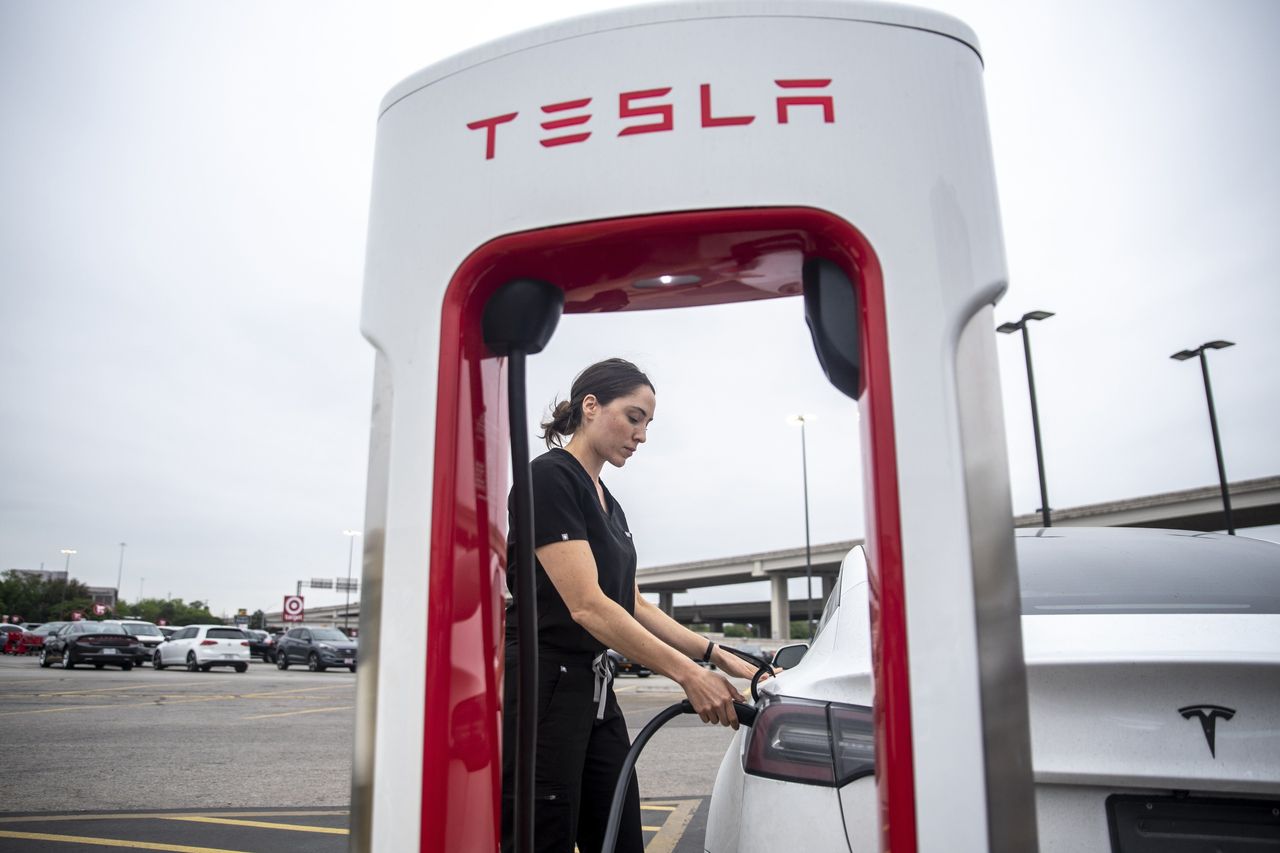Tesla Posts Record US$3.3 Billion Quarterly Profit
Elon Musk predicts rapid recovery in vehicle production in China to drive strong growth in total output.
Tesla Inc. posted a greater than sevenfold increase in first-quarter profit to reach a record as Chief Executive Elon Musk said the company could boost vehicle production more than expected this year despite supply-chain bottlenecks and disruptions in China.
Mr. Musk on Wednesday said Tesla likely would produce more than 1.5 million vehicles in 2022, up some 60% over last year. The company’s long-term goal is to increase vehicle deliveries by an average of 50% annually. Production in China would recover strongly, he said.
The world’s largest car company by value is recovering from a shutdown at its Shanghai factory, where work was suspended March 28 because of strict government measures meant to slow the spread of Covid-19. Tesla said it lost about a month of production from the shutdown.
“Shanghai is coming back with a vengeance,” Mr. Musk said as the company reported that sales in the first three months of the year had jumped roughly 80% from a year earlier to $18.76 billion, generating a record profit of US$3.32 billion. That topped the previous high of $2.3 billion set in the preceding quarter. Results beat Wall Street’s expectations for both sales and profit.
However, factories are likely to continue operating below capacity through 2022, due largely to supply chain bottlenecks, Tesla said.
Tesla delivered around 310,000 vehicles globally in the first quarter, up from 184,877 a year earlier and 308,650 in the fourth quarter.
Tesla shares closed down nearly 5% Wednesday, before advancing more than 4% in late trading after the company posted its quarterly results, which were buoyed by an uptick in revenue from regulatory credits.
The company sells the credits to rival auto makers that need them to comply with emissions-related rules. Such sales brought in $679 million in the most recent quarter aided by a one-time benefit, up from $518 million a year earlier. Credit sales have long been critical to Tesla’s bottom line, though they have dwindled in recent quarters. The company has said it would become less reliant on them.
Mr. Musk joined the Tesla earnings call almost a week after making a $43 billion nonbinding bid to take over Twitter Inc. The social-media company adopted a so-called poison pill a day after Mr. Musk made his offer. The move makes it harder for any investor to purchase 15% or more of the company’s stock. Mr. Musk, on the Tesla call, didn’t address the Twitter situation.
In Shanghai, Tesla had about a week’s worth of vehicle-parts inventory at its factory and was working with local authorities and suppliers to address logistics problems, local government-run Shanghai Television reported.
Shanghai-area manufacturers have had trouble getting parts delivered, because China’s travel restrictions have made it difficult for trucks to enter the region, analysts have said.
Customers, meanwhile, are having to wait longer to get behind the wheel of a new Tesla. As of March, U.S. buyers could expect to wait roughly eight months for a new long-range Model Y compact sport-utility vehicle, one of Tesla’s most popular models, according to Bernstein Research. Delivery lead times historically have been around two to eight weeks domestically, the firm said.
Tesla in recent weeks delivered its first Model Ys made at its new plants in Germany and Texas. Mr. Musk has said localizing production would improve Tesla’s economics in the long run.
The auto maker has been charging more for its cars amid inflation and persistent supply-chain bottlenecks. The cost of one configuration of the Model Y jumped 30% in the year ended in March, according to Bernstein. Price increases in China haven’t been as extreme, ranging between 5% and 11% in the same period, depending on the model, Bernstein data show.
In some cases, Mr. Musk said, suppliers are requesting 20% to 30% more for parts than they did last year. “I think the official numbers actually understate the true magnitude of inflation,” Mr. Musk said.
Tesla signaled software sales would become an increasingly important profit driver. By the end of the year, it said it expects an advanced driver-assistance feature designed to help vehicles navigate cities to be available to everyone in the U.S. who has purchased Tesla’s “Full Self-Driving” package. Tesla has been gradually releasing trial versions of the technology, which more than 100,000 people are testing, Mr. Musk said in a recent TED interview. The system, which costs $12,000 upfront, doesn’t make vehicles autonomous.
Mr. Musk on Wednesday provided additional details about the dedicated robotaxi he teased earlier this month, saying he hopes the vehicle, which won’t have a steering wheel or pedals, will enter volume production in 2024. He said a trip in such a vehicle would cost less than a bus ticket.
Tesla is working to open the company’s fast-charging network in the U.S. to electric vehicles made by other manufacturers, Senior Vice President Andrew Baglino said. The company launched a pilot program last year that allows non-Tesla drivers in parts of Europe to use its charging network.
The company also is taking steps to enable more of its customers to insure their vehicles through Tesla. It’s aiming for 80% of U.S. customers to have access to a Tesla insurance product by the end of the year, Chief Financial Officer Zachary Kirkhorn said.
The auto maker, like many in the industry, is also contending with soaring costs for the materials used in the rechargeable batteries that power electric vehicles. Raw materials account for 80% of the cost of a lithium-ion battery, up from 40% in 2015, according to Benchmark Mineral Intelligence, which tracks the battery supply chain.
Mr. Musk, who tweeted earlier this month that lithium prices had “gone to insane levels,” revisited the idea that Tesla might get into the business of mining and refining the metal and urged others to do so as well.
Tesla has flirted with that prospect for years and even neared deals in the middle of last decade to buy lithium mines in the U.S. and Argentina, according to a person familiar with the matter. But the company didn’t follow through with those acquisitions as it gave priority to production of its Model 3 sedan, the person said. In the years since, the balance of power has shifted toward suppliers as car companies from Ford Motor Co. and Volkswagen AG to newcomer Rivian Automotive Inc. scramble to secure the materials they need to meet ambitious electric-vehicle production targets. Ford and General Motors Co. are scheduled to report earnings next week. Rivian’s quarterly results are due in May.
Lithium carbonate prices averaged around $60,800 per metric ton in March, up roughly $50,000 from a year earlier, Benchmark data show.
—Raffaele Huang contributed to this article.
 Copyright 2020, Dow Jones & Company, Inc. All Rights Reserved Worldwide. LEARN MORE
Copyright 2020, Dow Jones & Company, Inc. All Rights Reserved Worldwide. LEARN MORE
This stylish family home combines a classic palette and finishes with a flexible floorplan
Just 55 minutes from Sydney, make this your creative getaway located in the majestic Hawkesbury region.
As Paris makes its final preparations for the Olympic games, its residents are busy with their own—packing their suitcases, confirming their reservations, and getting out of town.
Worried about the hordes of crowds and overall chaos the Olympics could bring, Parisians are fleeing the city in droves and inundating resort cities around the country. Hotels and holiday rentals in some of France’s most popular vacation destinations—from the French Riviera in the south to the beaches of Normandy in the north—say they are expecting massive crowds this year in advance of the Olympics. The games will run from July 26-Aug. 1.
“It’s already a major holiday season for us, and beyond that, we have the Olympics,” says Stéphane Personeni, general manager of the Lily of the Valley hotel in Saint Tropez. “People began booking early this year.”
Personeni’s hotel typically has no issues filling its rooms each summer—by May of each year, the luxury hotel typically finds itself completely booked out for the months of July and August. But this year, the 53-room hotel began filling up for summer reservations in February.
“We told our regular guests that everything—hotels, apartments, villas—are going to be hard to find this summer,” Personeni says. His neighbours around Saint Tropez say they’re similarly booked up.
As of March, the online marketplace Gens de Confiance (“Trusted People”), saw a 50% increase in reservations from Parisians seeking vacation rentals outside the capital during the Olympics.
Already, August is a popular vacation time for the French. With a minimum of five weeks of vacation mandated by law, many decide to take the entire month off, renting out villas in beachside destinations for longer periods.
But beyond the typical August travel, the Olympics are having a real impact, says Bertille Marchal, a spokesperson for Gens de Confiance.
“We’ve seen nearly three times more reservations for the dates of the Olympics than the following two weeks,” Marchal says. “The increase is definitely linked to the Olympic Games.”

Getty Images
According to the site, the most sought-out vacation destinations are Morbihan and Loire-Atlantique, a seaside region in the northwest; le Var, a coastal area within the southeast of France along the Côte d’Azur; and the island of Corsica in the Mediterranean.
Meanwhile, the Olympics haven’t necessarily been a boon to foreign tourism in the country. Many tourists who might have otherwise come to France are avoiding it this year in favour of other European capitals. In Paris, demand for stays at high-end hotels has collapsed, with bookings down 50% in July compared to last year, according to UMIH Prestige, which represents hotels charging at least €800 ($865) a night for rooms.
Earlier this year, high-end restaurants and concierges said the Olympics might even be an opportunity to score a hard-get-seat at the city’s fine dining.
In the Occitanie region in southwest France, the overall number of reservations this summer hasn’t changed much from last year, says Vincent Gare, president of the regional tourism committee there.
“But looking further at the numbers, we do see an increase in the clientele coming from the Paris region,” Gare told Le Figaro, noting that the increase in reservations has fallen directly on the dates of the Olympic games.
Michel Barré, a retiree living in Paris’s Le Marais neighbourhood, is one of those opting for the beach rather than the opening ceremony. In January, he booked a stay in Normandy for two weeks.
“Even though it’s a major European capital, Paris is still a small city—it’s a massive effort to host all of these events,” Barré says. “The Olympics are going to be a mess.”
More than anything, he just wants some calm after an event-filled summer in Paris, which just before the Olympics experienced the drama of a snap election called by Macron.
“It’s been a hectic summer here,” he says.

AFP via Getty Images
Parisians—Barré included—feel that the city, by over-catering to its tourists, is driving out many residents.
Parts of the Seine—usually one of the most popular summertime hangout spots —have been closed off for weeks as the city installs bleachers and Olympics signage. In certain neighbourhoods, residents will need to scan a QR code with police to access their own apartments. And from the Olympics to Sept. 8, Paris is nearly doubling the price of transit tickets from €2.15 to €4 per ride.
The city’s clear willingness to capitalise on its tourists has motivated some residents to do the same. In March, the number of active Airbnb listings in Paris reached an all-time high as hosts rushed to list their apartments. Listings grew 40% from the same time last year, according to the company.
With their regular clients taking off, Parisian restaurants and merchants are complaining that business is down.
“Are there any Parisians left in Paris?” Alaine Fontaine, president of the restaurant industry association, told the radio station Franceinfo on Sunday. “For the last three weeks, there haven’t been any here.”
Still, for all the talk of those leaving, there are plenty who have decided to stick around.
Jay Swanson, an American expat and YouTuber, can’t imagine leaving during the Olympics—he secured his tickets to see ping pong and volleyball last year. He’s also less concerned about the crowds and road closures than others, having just put together a series of videos explaining how to navigate Paris during the games.
“It’s been 100 years since the Games came to Paris; when else will we get a chance to host the world like this?” Swanson says. “So many Parisians are leaving and tourism is down, so not only will it be quiet but the only people left will be here for a party.”
This stylish family home combines a classic palette and finishes with a flexible floorplan
Just 55 minutes from Sydney, make this your creative getaway located in the majestic Hawkesbury region.






















